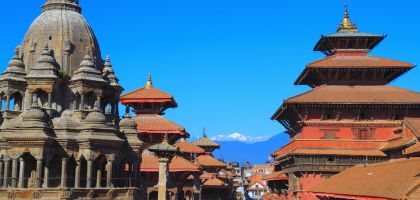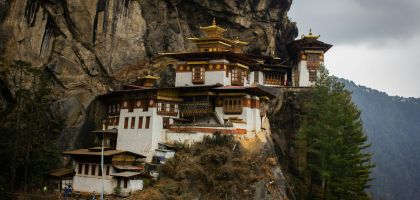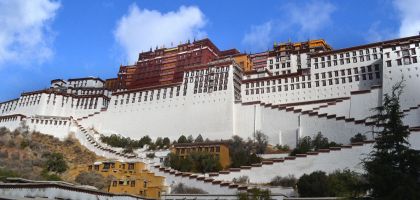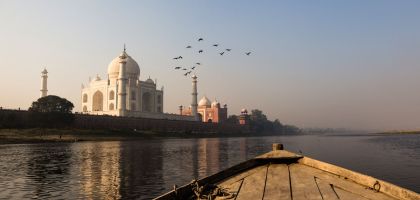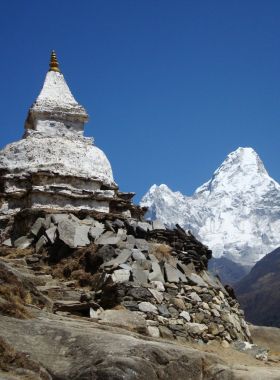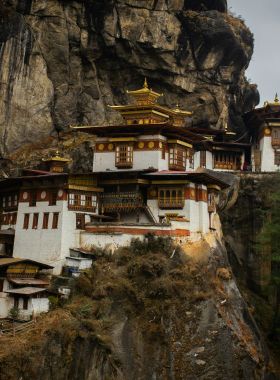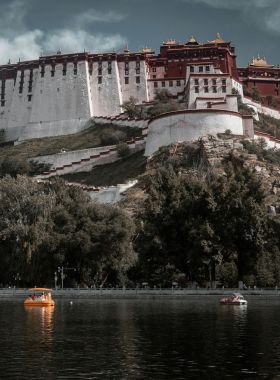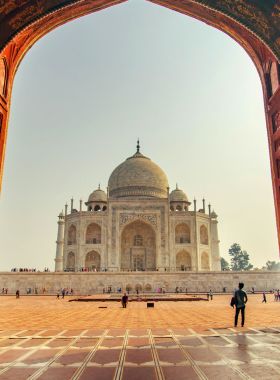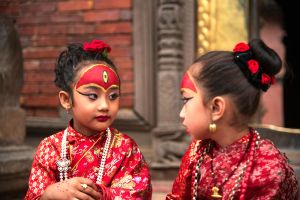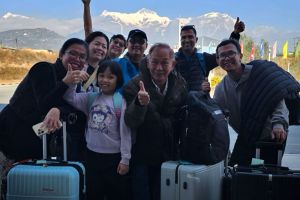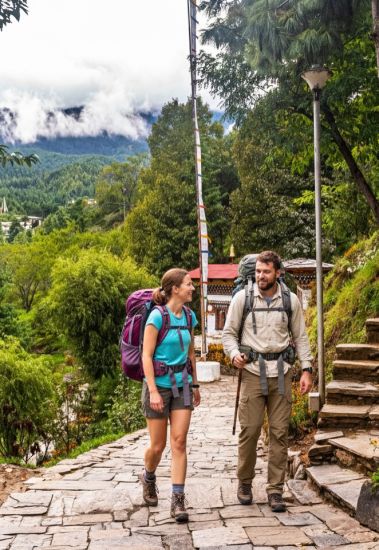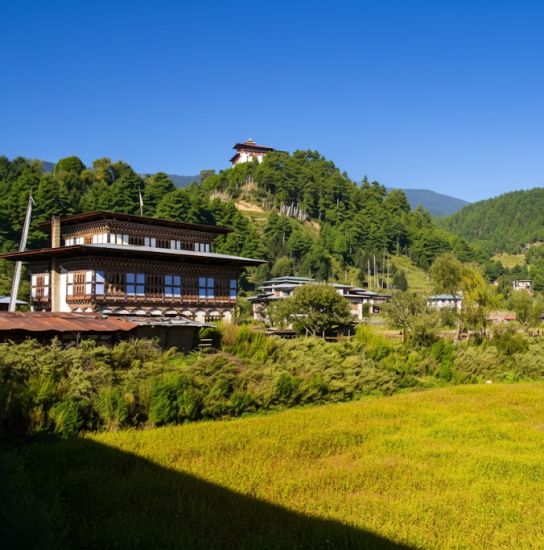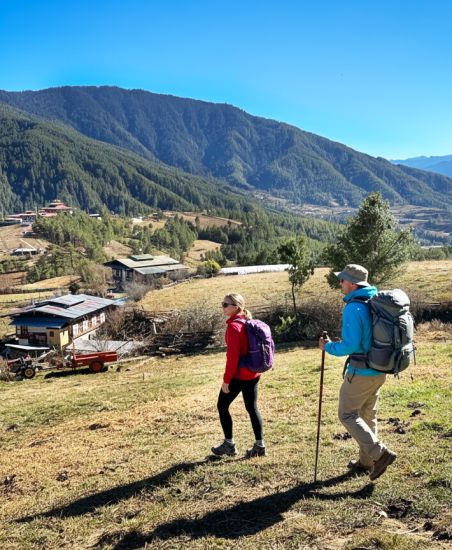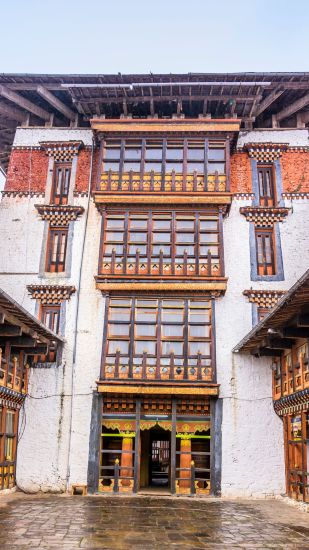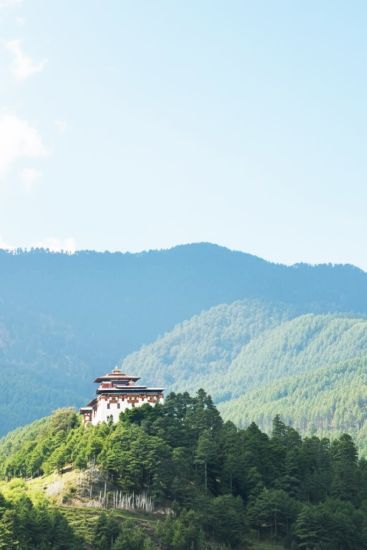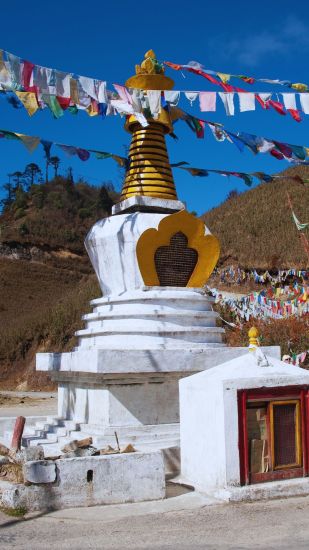Bumthang Cultural Trek
13 Days / Bhutan
Activity
Difficulty Level
Destinations
Trip Start / End
Max Altitude
Accommodation
Travel Style
Best time to travel
Personalized Travel Advice

Dev Raj Nepal
+977 9851096523
Personalized Travel Advice

Dev Raj Nepal
+977 9851096523
Detailed Itinerary
01
DAY
01
Arrive at Paro International Airport and step into the serene magic of Bhutan, where warmth and wonder await. Begin your adventure with a picturesque drive to Thimphu, the peaceful capital, passing through emerald valleys and mist-covered mountains. On the way, stop at Tachogang Lhakhang, also known as Tamchog Lhakhang, a 15th-century monastery built by the legendary Tibetan saint and bridge builder Thangtong Gyalpo. The ancient iron chain bridge sways above the Paro Chhu River, surrounded by vivid murals and sacred stillness, offering a perfect prelude to Bhutan’s spiritual landscape.
Upon reaching Thimphu, settle into your hotel and take part in a warm welcome briefing that introduces Bhutan’s living traditions, rituals, and deeply rooted customs. This evening marks the peaceful beginning of your Bhutan trek with culture, a journey where each moment draws you closer to the soul of the Thunder Dragon Kingdom. Breathe in the crisp Himalayan air, relax, and share stories with fellow travelers as anticipation builds for the days ahead.
Paro Arrival – Drive to Thimphu
Arrive at Paro International Airport and step into the serene magic of Bhutan, where warmth and wonder await. Begin your adventure with a picturesque drive to Thimphu, the peaceful capital, passing through emerald valleys and mist-covered mountains. On the way, stop at Tachogang Lhakhang, also known as Tamchog Lhakhang, a 15th-century monastery built by the legendary Tibetan saint and bridge builder Thangtong Gyalpo. The ancient iron chain bridge sways above the Paro Chhu River, surrounded by vivid murals and sacred stillness, offering a perfect prelude to Bhutan’s spiritual landscape.
Upon reaching Thimphu, settle into your hotel and take part in a warm welcome briefing that introduces Bhutan’s living traditions, rituals, and deeply rooted customs. This evening marks the peaceful beginning of your Bhutan trek with culture, a journey where each moment draws you closer to the soul of the Thunder Dragon Kingdom. Breathe in the crisp Himalayan air, relax, and share stories with fellow travelers as anticipation builds for the days ahead.
02
DAY
02
As the valley stirs to life, enjoy a hearty breakfast before setting out to Buddha Point, home to the majestic Buddha Dordenma. Standing 51 meters tall, this monumental bronze statue gazes serenely over Thimphu Valley and ranks among the largest Buddha statues in the world. The tranquil setting and sweeping Himalayan views create a perfect space for reflection, inspiration, and spiritual calm.
Your Bhutan trek with culture continues with a visit to Changangkha Lhakhang, a 12th-century hilltop temple dedicated to the protective deity of children. Its sacred murals and ancient statues tell stories of devotion, while the terraces below reveal panoramic views of Thimphu. This timeless sanctuary offers a glimpse into Bhutanese Buddhist life and a moment of peaceful contemplation.
Next, explore the Institute of Zorig Chusum, where students master Bhutan’s 13 traditional arts, from painting and sculpture to weaving and woodcarving. Observing their craft reveals the deep respect for creativity and heritage that sustains Bhutan’s cultural identity.
Wander through the Crafts Bazaar, a lively market filled with handmade textiles, jewelry, and local handicrafts. Here, you can support Bhutanese artisans and experience the country’s living artistic traditions up close.
Pause at the National Memorial Chorten, a revered monument built in honor of Bhutan’s third king. Locals gather here daily for prayer and circumambulation, offering a heartfelt window into the spiritual rhythm of Bhutanese life.
End the day at Tashichho Dzong, the grand fortress-monastery that houses both monastic quarters and government offices. With its golden roofs, ornate courtyards, and glowing presence at sunset, the dzong captures the harmonious balance of faith, governance, and artistry that defines Bhutan.
Spend the night at your hotel in Thimphu, reflecting on a day that beautifully intertwines spirituality, art, and the cultural spirit of your Bhutan trek with culture.
Thimphu Exploration
As the valley stirs to life, enjoy a hearty breakfast before setting out to Buddha Point, home to the majestic Buddha Dordenma. Standing 51 meters tall, this monumental bronze statue gazes serenely over Thimphu Valley and ranks among the largest Buddha statues in the world. The tranquil setting and sweeping Himalayan views create a perfect space for reflection, inspiration, and spiritual calm.
Your Bhutan trek with culture continues with a visit to Changangkha Lhakhang, a 12th-century hilltop temple dedicated to the protective deity of children. Its sacred murals and ancient statues tell stories of devotion, while the terraces below reveal panoramic views of Thimphu. This timeless sanctuary offers a glimpse into Bhutanese Buddhist life and a moment of peaceful contemplation.
Next, explore the Institute of Zorig Chusum, where students master Bhutan’s 13 traditional arts, from painting and sculpture to weaving and woodcarving. Observing their craft reveals the deep respect for creativity and heritage that sustains Bhutan’s cultural identity.
Wander through the Crafts Bazaar, a lively market filled with handmade textiles, jewelry, and local handicrafts. Here, you can support Bhutanese artisans and experience the country’s living artistic traditions up close.
Pause at the National Memorial Chorten, a revered monument built in honor of Bhutan’s third king. Locals gather here daily for prayer and circumambulation, offering a heartfelt window into the spiritual rhythm of Bhutanese life.
End the day at Tashichho Dzong, the grand fortress-monastery that houses both monastic quarters and government offices. With its golden roofs, ornate courtyards, and glowing presence at sunset, the dzong captures the harmonious balance of faith, governance, and artistry that defines Bhutan.
Spend the night at your hotel in Thimphu, reflecting on a day that beautifully intertwines spirituality, art, and the cultural spirit of your Bhutan trek with culture.
03
DAY
03
Begin your day at the Folk Heritage Museum, a fascinating window into traditional rural life in Bhutan. Explore beautifully restored farmhouses filled with antique household items, farming tools, and local attire that together tell the story of Bhutanese daily life, customs, and celebrations passed down through generations.
Continue your Bhutan trek with culture at the National Textile Museum, a showcase of Bhutan’s rich weaving traditions. Admire exquisite handwoven fabrics and ceremonial garments, each pattern reflecting regional styles, lineage, and spiritual meaning. The museum offers a deep appreciation of the artistry and devotion behind Bhutan’s textile heritage.
Next, visit the Bhutan Postal Museum, where the nation’s evolution is traced through historic stamps, vintage postal equipment, and rare archival exhibits. Beyond its collection, the museum captures Bhutan’s transformation and creativity, connecting communication with culture in an engaging way.
In the afternoon, embark on a scenic drive to Punakha, pausing at Dochula Pass, perched at 3,100 meters. From here, enjoy panoramic views of the snow-capped Himalayas, including Gangkar Puensum, Bhutan’s highest peak. The 108 memorial chortens built by the Queen Mother stand as symbols of peace and reverence, adding a profound spiritual presence to this breathtaking viewpoint.
Arrive in Punakha, the former winter capital, nestled at the confluence of the Pho Chhu and Mo Chhu rivers. Surrounded by fertile valleys and lush rice fields, Punakha embodies Bhutan’s harmony of history, spirituality, and nature. Settle into your accommodation and unwind as you reflect on a day filled with insight, artistry, and connection, the perfect continuation of your Bhutan trek with culture.
Thimphu – Punakha
Begin your day at the Folk Heritage Museum, a fascinating window into traditional rural life in Bhutan. Explore beautifully restored farmhouses filled with antique household items, farming tools, and local attire that together tell the story of Bhutanese daily life, customs, and celebrations passed down through generations.
Continue your Bhutan trek with culture at the National Textile Museum, a showcase of Bhutan’s rich weaving traditions. Admire exquisite handwoven fabrics and ceremonial garments, each pattern reflecting regional styles, lineage, and spiritual meaning. The museum offers a deep appreciation of the artistry and devotion behind Bhutan’s textile heritage.
Next, visit the Bhutan Postal Museum, where the nation’s evolution is traced through historic stamps, vintage postal equipment, and rare archival exhibits. Beyond its collection, the museum captures Bhutan’s transformation and creativity, connecting communication with culture in an engaging way.
In the afternoon, embark on a scenic drive to Punakha, pausing at Dochula Pass, perched at 3,100 meters. From here, enjoy panoramic views of the snow-capped Himalayas, including Gangkar Puensum, Bhutan’s highest peak. The 108 memorial chortens built by the Queen Mother stand as symbols of peace and reverence, adding a profound spiritual presence to this breathtaking viewpoint.
Arrive in Punakha, the former winter capital, nestled at the confluence of the Pho Chhu and Mo Chhu rivers. Surrounded by fertile valleys and lush rice fields, Punakha embodies Bhutan’s harmony of history, spirituality, and nature. Settle into your accommodation and unwind as you reflect on a day filled with insight, artistry, and connection, the perfect continuation of your Bhutan trek with culture.
04
DAY
04
After an early breakfast, we begin our journey toward Jakar, setting off over the impressive Pele La Pass, perched at about 3,420 meters. The pass marks a dramatic boundary between Bhutan’s western and central regions, with sweeping views into deep valleys and often a display of fluttering prayer flags at the summit. Stop for lunch en route, and then take time to explore the majestic Trongsa Dzong. Towering on a rocky spur above the Mangde Chhu gorge, this fortress‐monastery is one of Bhutan’s architectural marvels, built in layers cascading down the hillside, with courtyards, broad staircases, narrow corridors, and richly decorated temples.
After your visit, continue the drive toward Bumthang, crossing the Yotong La Pass at about 3,425 meters. As you descend into Bumthang, the landscape shifts: gentle valleys, lush fields, apple orchards, old monasteries and temples peeking from forested hills. Arrival in Jakar marks your entrance into the spiritual heartland of Bhutan, where ancient stories, sacred sites, and the culture of the high valleys await.
Punakha – Bumthang
After an early breakfast, we begin our journey toward Jakar, setting off over the impressive Pele La Pass, perched at about 3,420 meters. The pass marks a dramatic boundary between Bhutan’s western and central regions, with sweeping views into deep valleys and often a display of fluttering prayer flags at the summit. Stop for lunch en route, and then take time to explore the majestic Trongsa Dzong. Towering on a rocky spur above the Mangde Chhu gorge, this fortress‐monastery is one of Bhutan’s architectural marvels, built in layers cascading down the hillside, with courtyards, broad staircases, narrow corridors, and richly decorated temples.
After your visit, continue the drive toward Bumthang, crossing the Yotong La Pass at about 3,425 meters. As you descend into Bumthang, the landscape shifts: gentle valleys, lush fields, apple orchards, old monasteries and temples peeking from forested hills. Arrival in Jakar marks your entrance into the spiritual heartland of Bhutan, where ancient stories, sacred sites, and the culture of the high valleys await.
05
DAY
05
Your Bumthang cultural trek begins today as we hike from the village of Tangbi toward Ngang Lhakhang, also known as the “Swan Temple.” The trek covers about 12 km and takes 4-5 hours, with a gradual ascent of around 170 meters, arriving at an altitude of approximately 2,800 meters (about 9,500 feet).
We start by following the Chamkhar Chu River, famous among locals for its trout, as the trail weaves through open meadows and small villages. There are chances to pause and interact with villagers, who often welcome trekkers with smiles and stories of their daily life. Along the way, we stop for lunch at Thangbi Lhakhang, a small temple with rustic charm, offering both sustenance and a glimpse into Bhutan’s layered spiritual history.
After lunch the path continues into the valley known as Ngang Yul — the “Land of the Swan,” so named for the flocks of swans once found here in olden times. In the heart of this valley sits Ngang Lhakhang, a monastery built in the 16th century by Lama Namkha Samdrup. It stands quietly, surrounded by prayer flags, rhododendrons, birch and blue pine trees, with sweeping valley views and a campsite nearby.
For overnight, we camp close to Ngang Lhakhang, under a sky ringing with stars, the air crisp, the forest shadows deep. It’s an evening to relax, share stories, maybe listen to the river, and let the calm of this sacred place settle in.
Trek to Ngang Lhakhang
Your Bumthang cultural trek begins today as we hike from the village of Tangbi toward Ngang Lhakhang, also known as the “Swan Temple.” The trek covers about 12 km and takes 4-5 hours, with a gradual ascent of around 170 meters, arriving at an altitude of approximately 2,800 meters (about 9,500 feet).
We start by following the Chamkhar Chu River, famous among locals for its trout, as the trail weaves through open meadows and small villages. There are chances to pause and interact with villagers, who often welcome trekkers with smiles and stories of their daily life. Along the way, we stop for lunch at Thangbi Lhakhang, a small temple with rustic charm, offering both sustenance and a glimpse into Bhutan’s layered spiritual history.
After lunch the path continues into the valley known as Ngang Yul — the “Land of the Swan,” so named for the flocks of swans once found here in olden times. In the heart of this valley sits Ngang Lhakhang, a monastery built in the 16th century by Lama Namkha Samdrup. It stands quietly, surrounded by prayer flags, rhododendrons, birch and blue pine trees, with sweeping valley views and a campsite nearby.
For overnight, we camp close to Ngang Lhakhang, under a sky ringing with stars, the air crisp, the forest shadows deep. It’s an evening to relax, share stories, maybe listen to the river, and let the calm of this sacred place settle in.
06
DAY
06
The trail rises steadily through lush meadows dotted with wildflowers and pine forests where shafts of morning light filter between the blue pines and junipers. The trek gradually climbs to Phephe La Pass, at approximately 3,360 meters (11,020 feet), the highest point of today’s journey. From the summit, enjoy panoramic views of rolling hills, distant Himalayan peaks, and the patchwork of valleys below. Prayer flags flutter in the breeze, marking the pass as a place of spiritual significance and reflection.
From Phephe La, the trail gently descends into the Tang Valley, arriving at Tahung, also called Meadow Camp. This peaceful high meadow is surrounded by forests and offers sweeping views of the valley. Settle into your camp or guesthouse, enjoy a warm meal, and take in the calm of this pristine environment. The evening sky here is a tapestry of stars, and the gentle sounds of the forest make for a serene end to the day.
Today’s trek is approximately 5–6 hours, combining moderate ascent with rewarding cultural and natural experiences, marking another memorable step on your Bhutan trek with culture.
Trek to Tahung
The trail rises steadily through lush meadows dotted with wildflowers and pine forests where shafts of morning light filter between the blue pines and junipers. The trek gradually climbs to Phephe La Pass, at approximately 3,360 meters (11,020 feet), the highest point of today’s journey. From the summit, enjoy panoramic views of rolling hills, distant Himalayan peaks, and the patchwork of valleys below. Prayer flags flutter in the breeze, marking the pass as a place of spiritual significance and reflection.
From Phephe La, the trail gently descends into the Tang Valley, arriving at Tahung, also called Meadow Camp. This peaceful high meadow is surrounded by forests and offers sweeping views of the valley. Settle into your camp or guesthouse, enjoy a warm meal, and take in the calm of this pristine environment. The evening sky here is a tapestry of stars, and the gentle sounds of the forest make for a serene end to the day.
Today’s trek is approximately 5–6 hours, combining moderate ascent with rewarding cultural and natural experiences, marking another memorable step on your Bhutan trek with culture.
07
DAY
07
Departing from the serene meadows of Tahung, the trail meanders through tranquil pine forests, with the gentle murmur of the Tang River accompanying your steps. As you traverse, the path offers glimpses into the daily lives of local villagers, with traditional Bhutanese homes dotting the landscape. The journey is not just a physical trek but a cultural immersion, as you encounter the rich heritage of the Bumthang Valley.
After approximately 5–6 hours of trekking, you arrive at Mesithang, a picturesque village nestled in the valley. Here, the landscape unfolds into expansive rice fields, and the architecture reflects the traditional Bhutanese style, with whitewashed walls and intricately designed wooden windows. The evening is spent in the warmth of a local farmhouse, where the aroma of freshly prepared Bhutanese cuisine fills the air, offering a taste of the region’s culinary delights.
As night falls, the sky above Mesithang transforms into a canvas of stars, providing a tranquil end to a day rich in natural beauty and cultural experiences.
Trek to Mesithang
Departing from the serene meadows of Tahung, the trail meanders through tranquil pine forests, with the gentle murmur of the Tang River accompanying your steps. As you traverse, the path offers glimpses into the daily lives of local villagers, with traditional Bhutanese homes dotting the landscape. The journey is not just a physical trek but a cultural immersion, as you encounter the rich heritage of the Bumthang Valley.
After approximately 5–6 hours of trekking, you arrive at Mesithang, a picturesque village nestled in the valley. Here, the landscape unfolds into expansive rice fields, and the architecture reflects the traditional Bhutanese style, with whitewashed walls and intricately designed wooden windows. The evening is spent in the warmth of a local farmhouse, where the aroma of freshly prepared Bhutanese cuisine fills the air, offering a taste of the region’s culinary delights.
As night falls, the sky above Mesithang transforms into a canvas of stars, providing a tranquil end to a day rich in natural beauty and cultural experiences.
08
DAY
08
Embark on a scenic trek from Mesithang to Taksha Village, immersing yourself in the tranquil landscapes and rich cultural heritage of the Bumthang Valley. This moderate hike offers a unique opportunity to experience rural Bhutanese life and the region’s natural beauty.
The trail meanders through lush meadows and dense pine forests, providing a serene atmosphere and occasional glimpses of local wildlife. As you ascend, the path offers panoramic views of the surrounding valleys and distant snow-capped peaks, enhancing the trekking experience.
Upon reaching Taksha Village, take time to explore this picturesque settlement. Taksha is renowned for its traditional Bhutanese architecture and the hospitality of its residents. Visit local homes to observe daily life and perhaps engage in conversations with villagers, gaining insights into their customs and traditions.
Trek to Taksha Village
Embark on a scenic trek from Mesithang to Taksha Village, immersing yourself in the tranquil landscapes and rich cultural heritage of the Bumthang Valley. This moderate hike offers a unique opportunity to experience rural Bhutanese life and the region’s natural beauty.
The trail meanders through lush meadows and dense pine forests, providing a serene atmosphere and occasional glimpses of local wildlife. As you ascend, the path offers panoramic views of the surrounding valleys and distant snow-capped peaks, enhancing the trekking experience.
Upon reaching Taksha Village, take time to explore this picturesque settlement. Taksha is renowned for its traditional Bhutanese architecture and the hospitality of its residents. Visit local homes to observe daily life and perhaps engage in conversations with villagers, gaining insights into their customs and traditions.
09
DAY
09
The day begins with a gentle trek from Taksha Village toward the historic Ugyen Choling Palace, weaving through the serene landscapes of the Tang Valley. The trail passes through terraced fields, small farmsteads, and pine forests, offering glimpses of everyday life in rural Bhutan. The air is crisp and invigorating, and the distant peaks of the Bumthang mountains provide a breathtaking backdrop for the journey.
Along the way, take time to admire the natural beauty surrounding the trail. Streams trickle alongside the path, and colorful prayer flags flutter above small shrines, marking sacred spots and adding spiritual resonance to the trek. Local villagers may greet you warmly, providing a rare chance to experience Bhutanese hospitality firsthand.
Arriving at Ugyen Choling Palace, explore this remarkable estate, now a museum that preserves traditional Bhutanese aristocratic life. Wander through the rooms filled with antique furniture, religious artifacts, and old household items, and stroll through the gardens where native flowers and plants flourish. The palace provides a fascinating insight into the history, culture, and architecture of Bumthang, making it a perfect culmination to the day’s journey.
As evening falls, settle into your accommodation near the palace, enjoying the quiet of the valley and reflecting on a day that blends natural beauty with rich cultural experiences.
Trek to Ugyen Choling
The day begins with a gentle trek from Taksha Village toward the historic Ugyen Choling Palace, weaving through the serene landscapes of the Tang Valley. The trail passes through terraced fields, small farmsteads, and pine forests, offering glimpses of everyday life in rural Bhutan. The air is crisp and invigorating, and the distant peaks of the Bumthang mountains provide a breathtaking backdrop for the journey.
Along the way, take time to admire the natural beauty surrounding the trail. Streams trickle alongside the path, and colorful prayer flags flutter above small shrines, marking sacred spots and adding spiritual resonance to the trek. Local villagers may greet you warmly, providing a rare chance to experience Bhutanese hospitality firsthand.
Arriving at Ugyen Choling Palace, explore this remarkable estate, now a museum that preserves traditional Bhutanese aristocratic life. Wander through the rooms filled with antique furniture, religious artifacts, and old household items, and stroll through the gardens where native flowers and plants flourish. The palace provides a fascinating insight into the history, culture, and architecture of Bumthang, making it a perfect culmination to the day’s journey.
As evening falls, settle into your accommodation near the palace, enjoying the quiet of the valley and reflecting on a day that blends natural beauty with rich cultural experiences.
10
DAY
10
Leave the serene surroundings of Ugyen Choling and embark on a scenic drive toward Trongsa, the historical heart of central Bhutan. The route winds through lush valleys, terraced fields, and traditional villages, offering glimpses of everyday rural life.
Along the way, cross Yotong La Pass and enjoy panoramic views of the surrounding mountains and valleys. Stop to take in the vast landscapes and capture photographs of the region’s natural beauty. The journey is punctuated by small villages where traditional Bhutanese homes and prayer flags add color and cultural depth to the scenery.
Upon reaching Trongsa, explore the imposing Trongsa Dzong, a fortress-monastery that towers above the valley. Its architecture and strategic location tell stories of Bhutanese history and governance, offering a fascinating glimpse into the country’s past. The town itself provides a charming atmosphere, with local markets and friendly villagers to welcome you.
Spend the night in Trongsa, resting and preparing for the next leg of your Bhutan cultural adventure.
Drive to Trongsa
Leave the serene surroundings of Ugyen Choling and embark on a scenic drive toward Trongsa, the historical heart of central Bhutan. The route winds through lush valleys, terraced fields, and traditional villages, offering glimpses of everyday rural life.
Along the way, cross Yotong La Pass and enjoy panoramic views of the surrounding mountains and valleys. Stop to take in the vast landscapes and capture photographs of the region’s natural beauty. The journey is punctuated by small villages where traditional Bhutanese homes and prayer flags add color and cultural depth to the scenery.
Upon reaching Trongsa, explore the imposing Trongsa Dzong, a fortress-monastery that towers above the valley. Its architecture and strategic location tell stories of Bhutanese history and governance, offering a fascinating glimpse into the country’s past. The town itself provides a charming atmosphere, with local markets and friendly villagers to welcome you.
Spend the night in Trongsa, resting and preparing for the next leg of your Bhutan cultural adventure.
11
DAY
11
Depart from Trongsa and set out on a full-day drive to Paro, winding through Bhutan’s dramatic central valleys and high mountain passes. The route traverses diverse landscapes, from lush farmland and dense forests to towering peaks dusted with snow, offering ever-changing scenery that highlights the natural beauty of the Kingdom.
Along the way, cross Pele La Pass (3,420 m), one of the highest points on the journey. Take time to pause, stretch, and marvel at the panoramic views of the surrounding mountains and valleys. The winding roads reveal small villages, traditional farms, and monasteries perched on hillsides, providing an authentic glimpse into rural Bhutanese life.
Upon arrival in Paro, check into your hotel and relax after the day’s journey. The remainder of the evening is free to enjoy the peaceful ambiance of the valley or take a short stroll around town, soaking in the crisp mountain air.
Trongsa – Paro
Depart from Trongsa and set out on a full-day drive to Paro, winding through Bhutan’s dramatic central valleys and high mountain passes. The route traverses diverse landscapes, from lush farmland and dense forests to towering peaks dusted with snow, offering ever-changing scenery that highlights the natural beauty of the Kingdom.
Along the way, cross Pele La Pass (3,420 m), one of the highest points on the journey. Take time to pause, stretch, and marvel at the panoramic views of the surrounding mountains and valleys. The winding roads reveal small villages, traditional farms, and monasteries perched on hillsides, providing an authentic glimpse into rural Bhutanese life.
Upon arrival in Paro, check into your hotel and relax after the day’s journey. The remainder of the evening is free to enjoy the peaceful ambiance of the valley or take a short stroll around town, soaking in the crisp mountain air.
12
DAY
12
Following breakfast in the morning, begin your journey at Satsam Chorten before embarking on a leisurely hike to the iconic Taktsang Monastery, also known as the “Tiger’s Nest.” Perched dramatically on a cliff nearly 800 meters above the Paro Valley, the monastery offers breathtaking panoramic views of the valley and the river below. According to legend, during the latter part of the 8th century, Guru Padma Sambhava, revered as the second Buddha in Bhutan, meditated here after descending on the back of a mystical flying tigress.
In the late afternoon, enjoy a stroll through the bustling streets of Paro’s bazaars, where colorful shops offer handicrafts, textiles, and souvenirs, reflecting Bhutan’s rich artistic traditions. This is an ideal time to interact with local artisans, observe daily life, and soak in the vibrant atmosphere of the valley town.
Optional: For those seeking relaxation after the day’s hike, an optional hot stone bath offers a traditional Bhutanese experience. Heated stones are placed in a wooden bath filled with water, creating a soothing, therapeutic soak that is believed to relieve muscle tension and rejuvenate the body, a perfect way to unwind and reflect on the day’s adventures.
Overnight in Paro, concluding a day filled with history, spirituality, and local culture, an unforgettable highlight of your Bhutan trek with culture.
Paro – Hike to Tiger’s Nest
Following breakfast in the morning, begin your journey at Satsam Chorten before embarking on a leisurely hike to the iconic Taktsang Monastery, also known as the “Tiger’s Nest.” Perched dramatically on a cliff nearly 800 meters above the Paro Valley, the monastery offers breathtaking panoramic views of the valley and the river below. According to legend, during the latter part of the 8th century, Guru Padma Sambhava, revered as the second Buddha in Bhutan, meditated here after descending on the back of a mystical flying tigress.
In the late afternoon, enjoy a stroll through the bustling streets of Paro’s bazaars, where colorful shops offer handicrafts, textiles, and souvenirs, reflecting Bhutan’s rich artistic traditions. This is an ideal time to interact with local artisans, observe daily life, and soak in the vibrant atmosphere of the valley town.
Optional: For those seeking relaxation after the day’s hike, an optional hot stone bath offers a traditional Bhutanese experience. Heated stones are placed in a wooden bath filled with water, creating a soothing, therapeutic soak that is believed to relieve muscle tension and rejuvenate the body, a perfect way to unwind and reflect on the day’s adventures.
Overnight in Paro, concluding a day filled with history, spirituality, and local culture, an unforgettable highlight of your Bhutan trek with culture.
13
DAY
13
Transfer to Paro International Airport for your onward flight, carrying memories of breathtaking landscapes, rich cultural encounters, and the warmth of Bhutanese hospitality. As the plane ascends, take one last look at the valleys, monasteries, and mountains, savoring the profound sense of peace and inspiration that Bhutan imparts.
Paro – Departure
Transfer to Paro International Airport for your onward flight, carrying memories of breathtaking landscapes, rich cultural encounters, and the warmth of Bhutanese hospitality. As the plane ascends, take one last look at the valleys, monasteries, and mountains, savoring the profound sense of peace and inspiration that Bhutan imparts.
Tour Cost
At High Asia Tours, we know that understanding tour costs is essential for planning your trip. Due to variables such as accommodation choices, meal plans, transportation options, group size, and seasonal demand, providing an exact price upfront is challenging.
To assist you, we offer a starting price to give a general idea of the cost:
The starting cost for this tour is
Includes / Excludes
Inclusions
-
All camping gears that includes – 2 person sleeping tent with floors and fly sheet, dinning tent, kitchen tent, toilet tents, dining tables, chairs, pillows and mattresses.
-
English speaking Guide.
-
Cook and kitchen aides.
-
All intercity transfers and sightseeing by a private vehicle.
-
Pack animals and animal drivers during trekking.
-
All necessary supplies.
-
3 meals a day.
-
Bhutan visa processing.
-
Sightseeing admission fees.
-
Bhutan visa fee
Exclusions
-
Airfare into and out of Bhutan.
-
Travel Insurance and emergency evacuation.
-
Expenses of personal nature like drinks, tip, telephone, laundry etc.
-
Extra expenses due to nature or unforeseen events such as flight cancellation, road blockade, no show etc.
Trip Info
Bhutan Trek with Culture
The Bhutan Trek with Culture offers far more than a journey through scenic landscapes; it is an immersion into the spiritual and cultural heart of the Thunder Dragon Kingdom. Unlike conventional treks that focus solely on physical challenge or wilderness, this trek weaves together Bhutan’s rich history, traditional villages, and sacred monasteries. Travelers experience a rhythm of life that has persisted for centuries, where every valley, monastery, and local home tells a story of heritage, devotion, and community. The trek is a living tapestry of Bhutanese culture, where encounters with villagers, artisans, and monks provide insight into customs that are rarely seen by outsiders.
What sets this Bumthang cultural trek apart is its seamless blend of natural beauty and cultural depth. From the terraced fields and pine forests of Mesithang to the historic Ugyen Choling Palace, each step is a journey through Bhutan’s unique past and present. Unlike high-altitude expeditions that prioritize extreme landscapes or adrenaline, the Bumthang Cultural Trek allows travelers to engage directly with the people, rituals, and crafts that define the region. Panoramic mountain vistas are complemented by intimate moments: sharing tea with a family in Taksha Village, walking through centuries-old monasteries, or observing sacred festivals that bring the valley to life.
Ultimately, the Bhutan Trek with Culture is a pilgrimage of both body and spirit. It is a journey where walking becomes a form of learning, and every mile traveled reveals the harmony between Bhutan’s people, their traditions, and the natural world. This trek transcends ordinary adventure travel, offering a rare opportunity to witness the Kingdom’s identity in its most authentic form. By blending gentle trekking with cultural discovery, it creates a profound connection to a land where history, spirituality, and landscape coexist in extraordinary balance.
Bumthang, often called the spiritual heart of Bhutan, is a region of breathtaking valleys, sacred monasteries, and rolling landscapes that seem untouched by time. Comprising four main valleys—Chokhor, Tang, Ura, and Choekhor—Bumthang is dotted with centuries-old temples, dzongs, and traditional farmsteads.
Its rich history and vibrant culture make it a unique destination where every village, monastery, and festival provides a window into Bhutanese traditions that have endured for generations. The valleys are also home to warm, welcoming communities whose daily lives reflect a harmonious balance between spirituality, agriculture, and cultural preservation.
Cultural trek in Bumthang allows travelers to experience this region in a deeply intimate and authentic way. Unlike driving along the main roads, trekking winds through hidden trails, high passes, and forested ridges, offering unobstructed views of the landscape and access to remote villages often missed by ordinary tourists.
Each step reveals the beauty of terraced fields, fluttering prayer flags, and the rhythm of rural life, while encounters with local villagers provide insights into ancient crafts, rituals, and customs. Trekking here turns the journey itself into a cultural experience, rather than just a series of destinations.
The natural and cultural landscapes of Bumthang are best appreciated at a human pace, where walking fosters both observation and reflection. The valleys, meadows, and monasteries are not only visually stunning but are also steeped in spiritual significance, with sacred sites tucked along the trail inviting quiet contemplation.
Bumthang Cultural Trek
Trekking allows travelers to engage with the environment fully, the scent of pine forests, the crisp mountain air, and the serene sounds of streams and birds—creating a sense of connection that cannot be captured from a vehicle. In Bumthang, trekking is the most immersive way to understand it’s traditions and culture.
The best time to experience this Bumthang Cultural trek is from March to May and September to November. During these months, Bhutan’s high-altitude valleys and trails come alive with clear skies, vibrant colors, and mild weather, making it ideal for trekking.
Spring (March to May) brings a spectacular bloom of rhododendrons, magnolias, and wildflowers, painting the landscape with color. The weather is generally mild, with warm days and cool nights, perfect for enjoying the breathtaking views of Bumthang’s lush valleys and forested hillsides.
Autumn (September to November) is another stunning season, offering crisp, clear skies and fresh mountain air. This time of year is celebrated for its harvest festivals, making it an ideal period to witness Bumthang’s unique cultural traditions alongside its natural beauty. The warm days and cooler nights during autumn also provide optimal trekking conditions.
For this Bhutan trek with culture, we prioritize both comfort and safety by providing well-maintained vehicles suited to the group size. If the group consists of fewer than 8 participants, we will use a high-roof Toyota HiAce, a spacious and reliable vehicle with ample legroom and luggage space. For groups larger than 8, we will upgrade to a Mini-bus, ensuring everyone has a comfortable and enjoyable journey together.
Our drivers are highly experienced professionals with extensive knowledge of the routes, terrain, and road conditions. They are trained in defensive driving and safety protocols, ensuring a smooth and secure travel experience. With years of experience navigating mountain roads and varying weather conditions, they prioritize passenger safety while maintaining a steady and comfortable ride.
Additionally, our vehicles undergo regular maintenance and safety checks to ensure reliability throughout the journey. Whether winding through mountain passes or traveling along scenic valleys, you can rest assured that your transportation is in capable hands, allowing you to fully enjoy the beauty of the destination without any worries.
Most parts of this Bhutan trek with culture will take you to the remote regions of Bhutan. Therefore, there is a scarcity of luxurious accommodations. At regional centers and big towns like Paro and Thimphu, we provide high grade hotels that provide comfort and warmth.
However, during this Bumthang Cultural trek, the accommodations are primarily in tents, where trekkers camp in designated spots at various points along the trail. These campsites are typically set up in meadows or near small villages, offering trekkers a chance to experience the beauty of the highlands up close. The camps are equipped with basic facilities like sleeping tents and shared dining tents, where meals are served. In some places, trekkers can stay in simple guesthouses or hotels that provide comfort before and after the trek. The accommodations are functional and designed to complement the trekking experience, offering a cozy respite after a long day on the trail.
Food on this typical Bhutan trek with Culture is mostly simple but nutritious, designed to provide energy for the long days of trekking. In the villages and towns, meals are typically served at local guesthouses, where you’ll find traditional Bhutanese dishes such as ema datshi (a spicy cheese and chili dish) and phaksha paa (pork with radishes). During the trek, meals are often prepared by the trek crew, including porters and cooks, and served at the campsites.
Expect to have a variety of hearty, locally sourced food, such as rice, vegetables, lentils, and noodles. Breakfast may include porridge, eggs, and bread, while dinners often consist of stews and curries. Given the high-altitude conditions, hydration is crucial, and water is regularly provided during the trek, though it’s recommended to drink purified water.
Clothing
- Light layers: T-shirts, long-sleeve shirts, and a couple of warm sweaters or fleeces.
- Thermal wear: Necessary for high-altitude areas and trekking days (especially for evenings).
- Outerwear: Warm, windproof jacket; waterproof jacket or poncho (for unexpected rain).
- Pants: Comfortable trekking pants and a few pairs of casual pants for cultural sites and town visits.
- Comfortable shoes: Hiking boots for trekking and sturdy, comfortable walking shoes for towns.
- Warm socks: Especially for trekking days at higher altitudes.
Accessories
- Hat, gloves, and scarf
- Sun hat and sunglasses
- Light daypack
- Trekking poles
- Quick-dry towel
Personal Items
- Toiletries: Soap, shampoo, toothbrush, toothpaste, and other personal hygiene items.
- Sunscreen and lip balm: High SPF for sun protection at high altitudes.
- Moisturizer: Dry weather may affect the skin.
- Hand sanitizer and wet wipes: For cleanliness on the go.
- First aid kit: Basic items like band-aids, pain relievers, blister treatment, altitude sickness medication (consult a doctor before traveling).
- Insect repellent: For rural areas.
Trekking Essentials
- Reusable water bottle
- Water purification tablets
- Energy snacks
- Headlamp or flashlight
Cultural Considerations
- Modest clothing: Long pants and long-sleeved shirts are preferred for monastery visits.
- Shawl or scarf: Useful when entering temples or Dzongs.
- Reusable bags: For storing and organizing belongings.
All international travelers (except citizens of India) require a visa for this Bumthang Cultural Trek. The visa process is straightforward but must be arranged in advance as there is no visa-on-arrival service for travelers.
As part of your Bhutan trek with culture, we will handle the entire visa application process for you, ensuring a hassle-free experience.
Once your Bumthang cultural trek is confirmed, we will submit your visa application to Bhutan’s Tourism Department on your behalf. Approved visas are typically issued as a clearance letter, which you’ll need to present at immigration upon arrival in Bhutan. The actual visa will then be stamped into your passport at the airport.
With us managing all the formalities, you can focus on enjoying your journey through the Land of the Thunder Dragon.
For more information, visit Official Bhutan Immigration Site
Risks
Altitude Sickness: As Bhutan’s terrain includes high altitudes, particularly in areas like Bumthang and the various mountain passes, altitude sickness can be a concern for some travelers. Symptoms may include headaches, dizziness, and fatigue. It’s important to stay hydrated, take things slow, and acclimatize properly to minimize the risk.
Weather Conditions: Weather in the Himalayan region can be unpredictable, with sudden changes in temperature and rainfall. During the trekking days, rain, snow, or fog can make trails slippery or obscure visibility, especially in high-altitude areas. Always be prepared with appropriate clothing, gear, and a flexible itinerary.
Physical Strain: The trek may be physically demanding, particularly on long days or during steep ascents. Participants should be in good physical health and prepared for the challenge of 4-7 hours of trekking each day. If you’re not accustomed to hiking, training beforehand can help reduce the risk of exhaustion or injury.
Limited Medical Facilities: Some regions, particularly remote trekking areas like Tang Valley and Bumthang, have limited access to medical facilities. It’s important to carry a basic first-aid kit and know emergency contact numbers. In case of severe health issues, evacuation may take time.
Rewards
Spectacular Scenic Views: The trek offers unmatched views of the Himalayas, including snow-capped peaks, lush valleys, and pristine rivers. From Chelila Pass (12,402 ft) to the beauty of Bumthang Valley, the landscapes will take your breath away. The varied terrains and changing scenery provide incredible photo opportunities.
Cultural Immersion: Exploring Bhutan means stepping into a world rich in culture, history, and spirituality. Visiting ancient monasteries like Ngang Lhakhang, participating in local traditions, and interacting with Bhutanese people allows for a unique cultural experience. Bhutan’s preservation of its heritage makes it one of the most authentic places for cultural travelers.
Spiritual Journey: The monasteries, chortens, and sacred sites you’ll visit, like the Memorial Chorten and Kyichu Lhakhang, provide a chance for reflection and spiritual growth. The peaceful surroundings and presence of monks and nuns create an atmosphere of serenity that fosters inner peace.
Unique Wildlife and Flora: Bhutan’s natural biodiversity is another significant reward. You’ll encounter unique flora like rhododendrons and oak trees, and wildlife including birds, deer, and possibly even the elusive snow leopard. The opportunity to observe Bhutan’s ecosystems up close makes the journey even more enriching.
Stunning Landscapes and Culture
Prepare to be awe-struck by the breathtaking beauty of Bhutan’s mountains, valleys, and forests. From the Paro Valley’s rolling hills and majestic peaks to the remote, untouched beauty of Bumthang Valley and Punakha, the landscapes are both varied and spectacular. You’ll traverse alpine meadows, dense forests, and ancient temples nestled in serene glades, offering views unlike any other place in the world. Additionally, Bhutan is one of the few places where ancient traditions and customs remain intact. Expect to encounter a culture steeped in Buddhist rituals, where monasteries like Kyichu Lhakhang and Ngang Lhakhang offer spiritual serenity. Be ready to learn about Bhutan’s deep-rooted history and traditions, from the majestic Tashichho Dzong in Thimphu to the fascinating textile techniques at the Yathra Textile Weaving Center.
Warm Hospitality and Beauty
Bhutanese people are known for their warmth and hospitality. Expect to be welcomed with open arms by the locals, who take pride in sharing their culture and heritage with visitors. Whether it’s a meal in a traditional home, a conversation with a local artisan, or a guide showing you around sacred sites, the Bhutanese will make you feel at home. Whether you’re walking through Tang Valley or enjoying the panoramic vistas from Chelila Pass, expect jaw-dropping scenery at every turn. High-altitude passes and mountain ridges will offer views of the Himalayas, including Mt. Jumolhari and other snow-capped peaks that are impossible to forget.
Tranquil Monasteries and Spiritual Sites
Every day will be an opportunity to explore the spiritual heart of Bhutan. Expect to visit sacred temples and monasteries such as Trongsa Dzong, Memorial Chorten, and Rimpochen Lhakhang, each offering a moment of peace and reflection. You’ll have the chance to witness Buddhist rituals, learn about the country’s spiritual history, and perhaps even meet monks who are dedicated to preserving the teachings of Buddhism.
Serenity and Discoveries
The stillness and peace that pervade Bhutan will provide a welcome respite from the hustle and bustle of modern life. Expect to feel a deep sense of calm as you explore the majestic landscapes and experience the country’s Gross National Happiness philosophy. The absence of mass tourism in many areas adds to the feeling of being in a remote, sacred space. As you explore the hidden gems of Bhutan, you will find that there’s always something new to discover. Whether it’s a hidden temple, a chance encounter with a local monk, or an unknown path that leads to a serene vista, each day offers new surprises that will make your journey unforgettable.
FAQs
Personalized Travel Advice

Dev Raj Nepal
+977 9851096523
